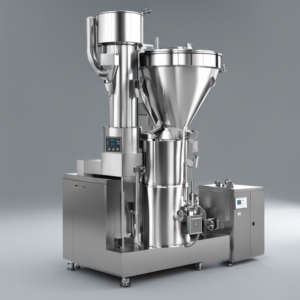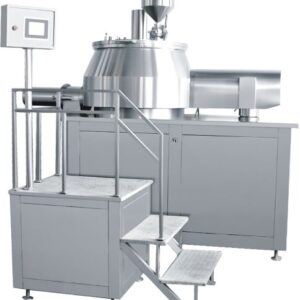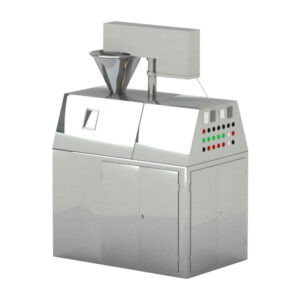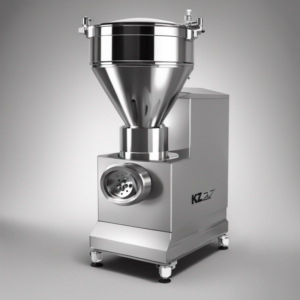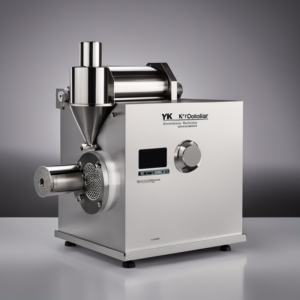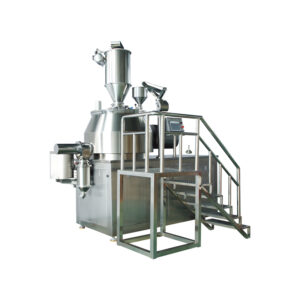Pharmaceutical Granulator
Welcome to the world of Qualipak Pharmaceuticals Granulator. Trust us with your production process for accuracy and effectiveness. Utilize our up-to-date technology that ensures homogenized mixtures leading to better product quality. Do not stress yourself about whether you are using the right granulation equipment because Qualipak has a variety. Take it easy on increasing productivity while improving quality at the same time.
Introduction of Pharmaceutical Granulator
Granulation is an important process in the pharmaceutical industry. This process involves the formation of granules from powders, which helps to enhance the flowability, compressibility and content uniformity of a pharmaceutical formulation. One of the key equipment used in this area is a Pharmaceutical Granulator. This article will explore various aspects of pharmaceutical granulators such as their types, working processes, applications, functions, benefits, future trends, maintenance and training.
Types of Pharmaceutical Granulators
Pharmaceutical Granulators come in different types each suited for specific production needs and processes. Some common types are:
Fluid Bed Granulators: Fluid bed granulators use the fluidization method to produce granules. Powder particles are suspended in a stream of air and sprayed with a binder solution leading to granule formation. For heat-sensitive materials and excellent flow properties, this is one suitable method.
High Shear Granulators: High shear granulators work by forcing powders through rotating blades or impellers at high speeds. The intense mechanical force generated by these blades leads to granule formation. This method works well with wet as well as dry methods of granulation.
Low Shear Granulators: Low shear granulators on the other hand operate at lower speeds resulting in gentler actions on powders than high shear ones. Heat or mechanically stressed material would be best suited here.
Roller Compactor Granulators: Roller compactor-granulator compresses powders between two counter-rotating rollers into compact sheets that are milled into granules later on; this technique is especially useful for difficult-to-granulate materials using traditional techniques.
Mixer Granulators: These combine mixing with granulation in one unit usually including a powder blending zone where binders are mixed with powders followed by a granulation step which forms granules thereafter.
Working Processes of Pharmaceutical Granulators
The working processes of pharmaceutical granulators differ according to their types but generally involve the following steps:
Preparation of Powder Blend: Homogeneity in the powder blend is achieved by mixing powders containing active pharmaceutical ingredients (APIs), binders, and excipients.
Granulation: The powder blend then undergoes granulation using the selected granulator. This stage entails adding a binder solution or other granulating agents that facilitate the formation of granules.
Drying: In wet granulation processes, the formed granules are typically wet and need to be dried to remove excess moisture. Fluid bed drying or tray drying can accomplish this.
Sizing: The desired particle size distribution may be achieved by sizing the dried granules. This step is important for maintaining uniformity in the final dosage form.
Blending: After sizing, lubricants or other additives may be blended with the granules before compression into tablets or encapsulation into capsules.
Applications of Pharmaceutical Granulators
The use of pharmaceutical granulators in the pharmaceutical industry is varied. They find uses such as:
Tablet Production: Granulation is an essential part of the tablet production process due to its ability to improve flow properties and compressibility of powders used leading to strong and consistent tablets being made.
Capsule Production: Gelatin capsules can encase these made-for-oral-administration-dosage forms when they are created from pharmaceutical granulators produced granules.
Modified-Release Formulations: To make modified-release formulations such as enteric-coated or sustained-release tablets designed to release the drug over a long time into the body or on particular sections of the gastrointestinal tract, granulation techniques can be used.
Granule Coating: The modification of the release profile, enhancement of stability and prevention of repugnant taste or smell can be done by coating granules produced by pharmaceutical granulators with polymers or other materials.
Formulation Development: The formulation development process in pharmaceutics is crucial in research where pharmaceutical granulators are used to optimize formulations for stability, bioavailability and patient compliance.
Functions of Pharmaceutical Granulators
Pharmaceutical granulators have several major roles in pharmaceutical manufacturing including.
Granulation: Pharma granulator’s main purpose is transforming fine powders into particles that possess better flow properties, compressibility and content uniformity.
Particle Size Control: Granulators allow one to control the particle size distribution of the particles effectively thus making it possible to achieve a uniform final dosage form.
Binder Incorporation: Binder solutions or wetting agents are incorporated into the powder blends by these machines, facilitating agglomeration and subsequent formation of granules.
Drying: Wet granules are dried using this equipment which also helps eliminate excess moisture for better stability purposes during wet granulation procedures.
Blending: Others possess blending functionality allowing for the homogenous spread of additives, lubricants and coating materials within the matrix of particles (granules).
Benefits of Pharmaceutical Granulators
The use of pharmaceutical granulators offers numerous benefits to the pharmaceutical industry, including:
Improved Product Quality: When more pills are made from powders by a traditional method called wet processing they become more compressed; therefore they acquire good flowability as well as uniformity (that is content uniformity), thus providing quality medicine forms.
Enhanced Process Efficiency: In both end-point and mid-stream production processes that involve many sequential steps such as weighing, blending/mixing, wet or dry granulation, compression and coating, pharmaceutical granulators make a considerable difference making the process shorter.
Flexibility in Formulation Development: By doing so, they permit the formulator to have as many possibilities as there are drug release requirements, thereby capturing different patient needs at once.
Consistency and Reproducibility: This ensures that products will perform equally without any changes in quality in general. Granulation processes carried out by pharmaceutical granulators provide consistent results and can be reproduced in case of errors during operation.
Cost Savings: Cost savings come up as a limited amount of materials are wasted if the production process is resolved accurately by these devices due to improved process efficiency or reduced waste generation.
Future Trends in Pharmaceutical Granulation
What are the upcoming trends that will determine the future of pharmaceutical granulation in the pharmaceutical industries?
Advanced Process Control: The employment of state-of-the-art technologies for process regulation such as Process Analytical Technology (PAT) and real-time monitoring systems will enable more precise control over granulation processes, leading to better product quality and higher procedural efficiency.
Continuous Manufacturing: Continuous manufacturing approaches are becoming popular in the pharmaceutical industry because they offer potential benefits including increased efficiencies, reduced waste and improved quality controls. Future granulation processes may incline towards continuous manufacturing platforms.
Use of Quality by Design (QbD) Principles: QbD principles focus on a systematic approach to product development and process optimization. QbD principles might be integrated into the pharmaceutical granulation processes thereby ensuring robust and reliable manufacturing processes.
Innovations in Binder Technologies: Better performing or functional binders that have been developed are other ways through which binder technology has been improved. This means that there is hope for optimal granulation procedures producing high-quality dosage forms.
Maintenance and Training
Regular Scheduled Maintenance
This can include cleaning out the pharmaceutical granulators, lubricating them, and inspecting worn parts during the scheduled maintenance plan. Regular maintenance of equipment is important since it prevents breakdowns allowing optimal performance.
Developing comprehensive training programs for maintenance personnel and operators including safety protocols, troubleshooting techniques, equipment operation and adherence to quality standards.
Keeping detailed records of maintenance activities that include dates of service, tasks performed as well as any issues encountered. Thus, this helps keep track of the history of the machine and determine any repetitive problems for timely resolution.
They also have pre-emptive monitoring systems such as predictive methods in place to ensure an early detection of impending issues before a devastating occurrence.
Maintenance and operational activities must focus on safety first. This will involve training employees on safety procedures, ensuring they use the appropriate personal protective equipment (PPE), and following laid down protocols that can mitigate risks thus preventing accidents.
Continuous improvement in all things is at the heart of the company’s maintenance culture where feedback from operators and other staff is desired to optimize equipment performance, efficiency gains as well as process improvements.
It would be beneficial if you could provide a broad range of skills and knowledge through cross-training opportunities for both maintenance staff and operators. With this kind of arrangement, one technician can stand in for another hence making the workforce more flexible.
Alternatively, suppliers may offer support services or technical training. These resources may include technical support lines, ‘fix it yourself’ handbooks or even tailor-made lessons matching specific machines’ configurations from these vendors.
The regular audits conducted on pharmaceutical granulators are aimed at ensuring compliance with regulatory requirements while identifying areas in need of improvement along the line maintenance practices and training programs too
Investing in high-tech innovation would do a lot to improve reliability efficiency levels together with the preciseness within which pharmaceutical granulators operate during their upkeep and utilization. Automation largely prevents human errors while also streamlining operations thereby resulting in efficient enterprise processes
Questions & Answers
- What is a pharmaceutical granulator?
A pharmaceutical granulator refers to a machine used within the pharmaceutical industry for converting particles into granules that are then compressed into tablets or capsules.
- What are the different types of pharmaceutical granulators?
Fluid bed granulators, high shear granulators, low shear granulators, roller compactor granulators and mixer granulators are some of the main types of pharmaceutical granulators.
- How does a pharmaceutical granulator work?
Depending on the type, a pharmaceutical manufacturing machine operates in different ways. Generally, wet or dry powder is made into wet/dry grains through fluidization, agitation, compression or rolling by mixing it with a binder solution or other suitable granulating agent.
- What are the applications of pharmaceutical granulators?
Pharmaceutical companies apply these machines for various purposes such as tablet production, capsule production, modified-release formulations, formulation development and finally Granule coating amongst others.
- What are the benefits associated with using pharmaceutical Granulator?
The use of these systems leads to better products’ quality; more efficient processes; flexible formulation development; consistent reproducibility of results; and reduced cost levels among others.
- How should maintenance be done on a pharmaceutical Granulator?
Cleaning at set intervals even during its operation time is serious business for pharma manufacturers. Therefore wear components have to be evaluated periodically to prevent damage and replacements should take place promptly whenever necessary whereas regular calibration exercises are always important while checking for any safety issues that could arise during normal operations including ongoing personnel training sessions to ensure they comprehend what’s going on around the facility
- What kind of training do you need to operate a pharmaceutical Granulator?
Granulation process operators require extensive training covering areas like equipment operation, safety protocols etc., quality requirements (Drugs), process monitoring (Chemical Engineering), troubleshooting skills (Life Sciences), compliance management (Quality Management) and continuous improvement tools/practices (Lean Manufacturing).
- How can safety be achieved when operating a pharmaceutical Granulator?
Proper employee education about procedures that should be taken into account when handling the equipment is an effective way of enhancing security within this area. The use of correct personal protection devices must be implemented and adhered to as well including lockout/tagout that must be used to prevent any accidents from happening. For instance, performing safety audits periodically.
- What are some future directions in pharmaceutical granulation?
Future trends in pharmaceutical granulation include enhanced process control technologies, continuous manufacturing techniques, the application of Quality by Design (QbD) principles, advancements in binder technologies, and the use of artificial intelligence (AI) and machine learning.
- Where can companies find support and resources for pharmaceutical granulators?
Pharmaceutical granulators can be supported through various avenues including equipment vendors, manufacturers, industry groups, technical journals, online discussion forums and tailored training schemes.

